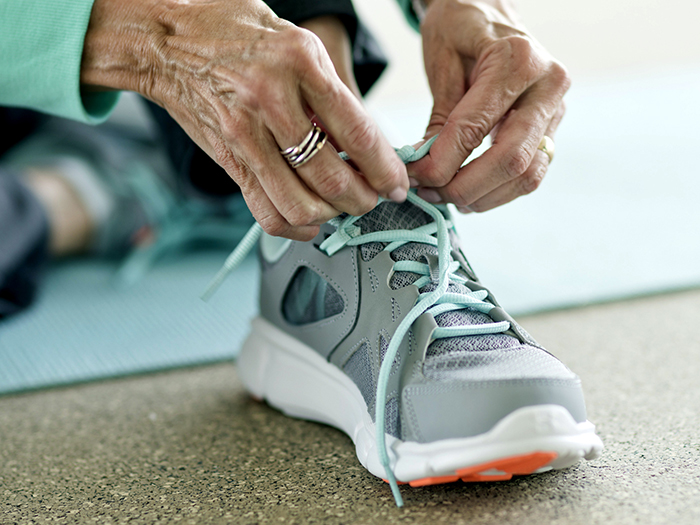5 Steps to Find the Right Workout Shoes
Supportive, comfortable shoes help protect your feet during exercise.

If the shoe fits, wear it. Your workouts will be more effective, and your feet will thank you. Unfortunately, there's a good chance your sneakers don't fit. With dozens of choices at the average shoe store, it's easy to choose the wrong one.
Find the perfect workout shoe for you by following these guidelines from Judith Baumhauer, M.D., a professor of orthopaedics at the University of Rochester Medical Center and a past president of the American Orthopaedic Foot and Ankle Society.
Step 1: Know Your Foot Structure
The right sneaker is like a good spouse: supportive in every way. That's why you need to understand your unique foot structure, Dr. Baumhauer says. The huge number of options is a blessing and a curse. Each shoe is tailored to a specific foot type, but you have to find the right one for your feet to ensure you don't injure yourself with repeated wear.
There are two standard foot measurements you need to consider: size and arch shape.
Check your size: Stand barefoot on a piece of paper, and trace your foot with a pen, Dr. Baumhauer recommends. Compare your tracing against your sneaker. There should be a half-inch of room above your toes and on the outside of each foot. Shoes that are too tight or too loose won’t provide the proper support and can cause painful blisters or calluses.
Measure your arch shape: Wet your feet, and walk across a floor that will show your footprints or step on a piece of paper. If you can see your whole footprint, you have a flat foot. Half a footprint indicates a normal arch. A very narrow footprint with just the outside edge visible signals a high arch. If you have normal or high arches, look for sneakers with arch support or use an over-the-counter insert. If you’re flat-footed, you generally don’t need a shoe that advertises arch support.
Of course, if you have had a foot injury or have a condition that affects your feet, follow any instructions from your doctor. If you have diabetes, which can increase your risk for foot problems, talk to your doctor about proper foot care.
Step 2: Know Your Foot Motion
Everyone moves with a different foot fall. The most common are neutral, overpronation, and supination. Overpronators naturally rotate their ankle inward when they step, while supinators rotate their foot outward. A neutral foot fall means your foot naturally rolls inward as you step forward but not to the extent of overpronation.
It's important to support your gait properly because prolonged overpronating or supinating can damage the foot and ankle. If you're unsure if you pronate or supinate, head to a running store or podiatrist, and have someone watch you jog. You can purchase shoes with motion control to support your foot and keep your step neutral. Look for a shoe with a stiff heel counter, the part of the shoe that keeps your heel in place. The heel counter wraps around the side and back of your heel to help support your gait.
Step 3: Trade Cotton Socks for Synthetic
Feet sweat. Socks made of fabric that retains moisture, like cotton, will rub against your feet and cause blisters or calluses. Instead, look for socks made from synthetic wicking fabric that's specially made for athletic wear.
Step 4: Tie Your Shoes Like This
How you lace your shoes can affect your comfort level. "If you have a high arch and a prominent mid-foot, tight laces can irritate the dorsal bossing," Dr. Baumhauer says, referring to the bony part on the top of your foot. "It will be like someone is stepping on top of your laces," she says.
To avoid pressure, try tying your shoes like this: Do a regular crisscrossing lace from the bottom, stopping before the bony part of your foot. Then string each lace between the eyes on the same side to create a hole across the tongue. Continue crisscross lacing above the gap.
Subscribe to our newsletter
It's quick and easy. You could be one of the 13 million people who are eligible.
Already a member? Click to discover our 15,000+ participating locations.
Follow Us
Step 5: Slowly Break in Your New Shoes
The good news for your wallet is that a good athletic shoe with the proper support for walking or running will also be good for indoor cardio and group exercise classes.
After you’ve sifted through the seemingly endless options and chosen your shoe, slowly break them in, especially if you’re new to exercise. Even if you have the best possible pair of shoes, going from zero to five days per week of exercise can injure your feet.
“The bones in your foot need to adapt to stress,” Dr. Baumhauer says. If your feet are used to exercise, it’s still important to slowly break in your new shoes. Try alternating between your old and new shoes every other workout for two weeks when making the transition. A healthy foot in the proper shoe shouldn’t be experiencing pain, she says.
Ultimately, one of the best judges of the right sneaker is the person who's wearing it. "If that shoe feels good and if you feel comfortable in it, it's probably a good one for you," Dr. Baumhauer says. "You shouldn't have to mold to your shoe-your shoe should fit you."
Take Your Favorite SilverSneakers Classes Online!
SilverSneakers members can access live fitness classes and wellness workshops through SilverSneakers LIVE. See the latest schedule and RSVP for classes here.
Not a member? If you have a Medicare Plan, it may include SilverSneakers—at no additional cost. Check your eligibility instantly here.





